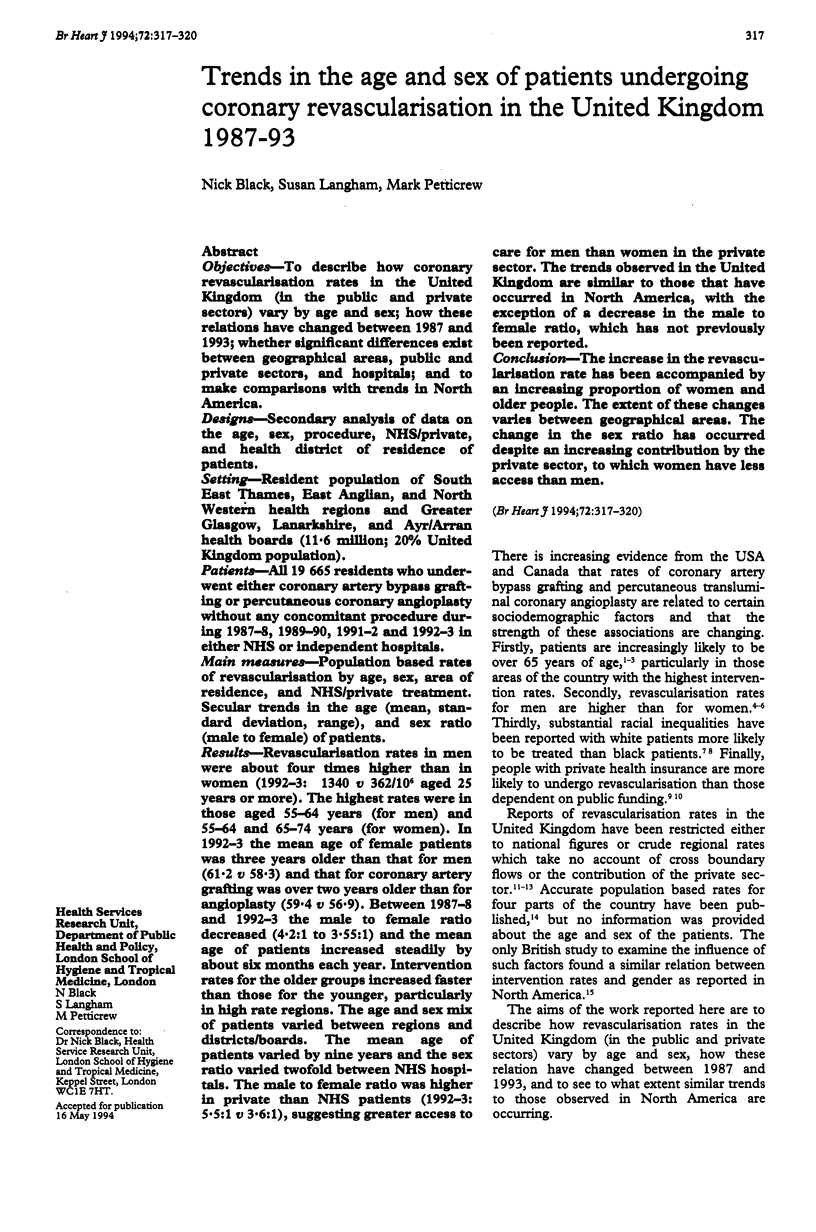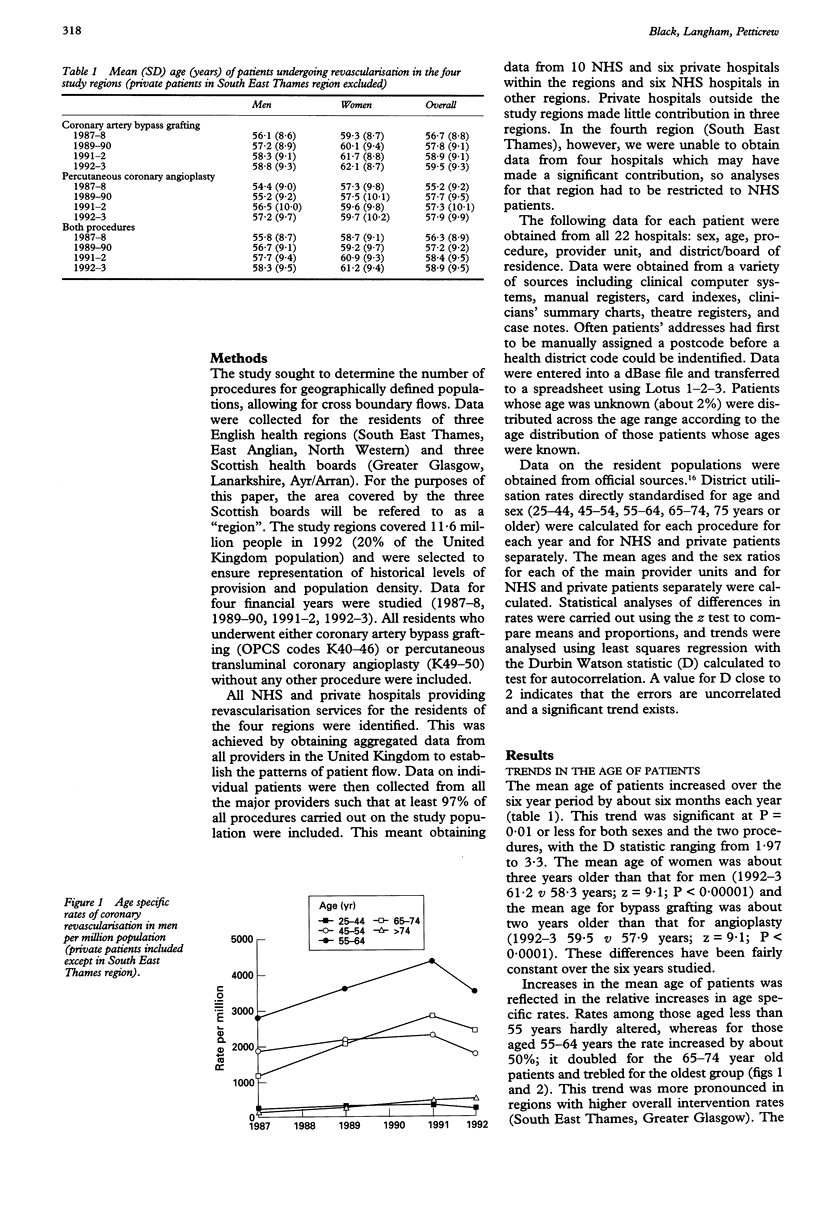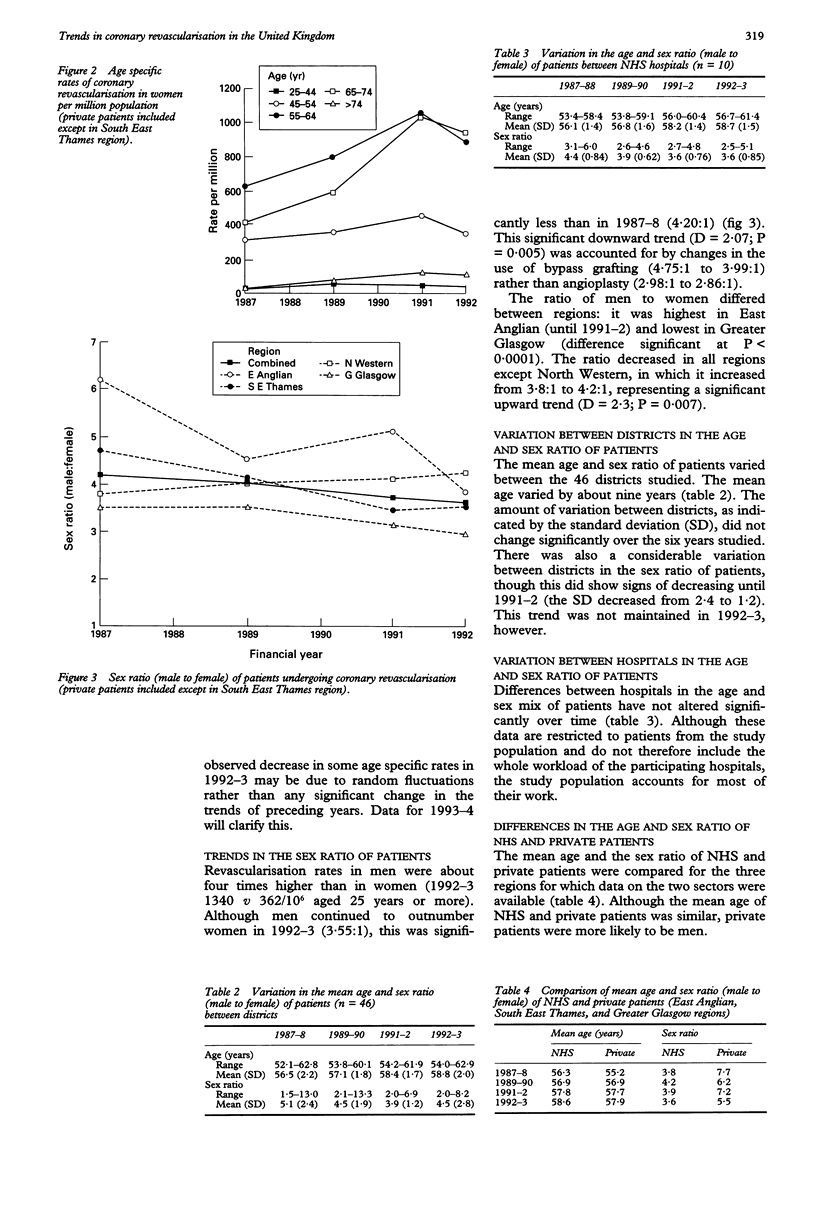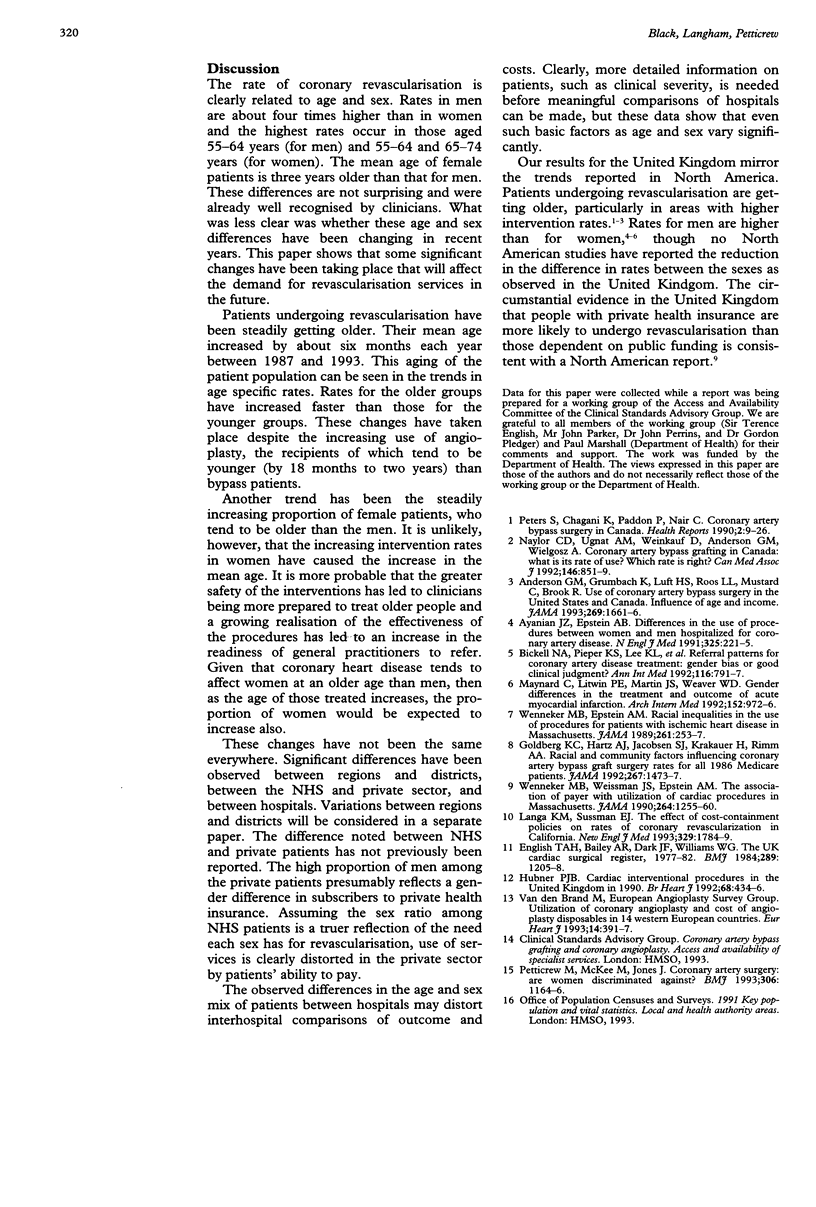Abstract
OBJECTIVES--To describe how coronary revascularisation rates in the United Kingdom (in the public and private sectors) vary by age and sex; how these relations have changed between 1987 and 1993; whether significant differences exist between geographical areas, public and private sectors, and hospitals; and to make comparisons with trends in North America. DESIGNS--Secondary analysis of data on the age, sex, procedure, NHS/private, and health district of residence of patients. SETTING--Resident population of South East Thames, East Anglian, and North Western health regions and Greater Glasgow, Lanarkshire, and Ayr/Arran health boards (11.6 million; 20% United Kingdom population). PATIENTS--All 19,665 residents who underwent either coronary artery bypass grafting or percutaneous coronary angioplasty without any concomitant procedure during 1987-8, 1989-90, 1991-2 and 1992-3 in either NHS or independent hospitals. MAIN MEASURES--Population based rates of revascularisation by age, sex, area of residence, and NHS/private treatment. Secular trends in the age (mean, standard deviation, range), and sex ratio (male to female) of patients. RESULTS--Revascularisation rates in men were about four times higher than in women (1992-3: 1340 v 362/10(6) aged 25 years or more). The highest rates were in those aged 55-64 years (for men) and 55-64 and 65-74 years (for women). In 1992-3 the mean age of female patients was three years older than that for men (61.2 v 58.3) and that for coronary artery grafting was over two years older than for angioplasty (59.4 v 56.9). Between 1987-8 and 1992-3 the male to female ratio decreased (4.2:1 to 3.55:1) and the mean age of patients increased steadily by about six months each year. Intervention rates for the older groups increased faster than those for the younger, particularly in high rate regions. The age and sex mix of patients varied between regions and districts/boards. The mean age of patients varied by nine years and the sex ratio varied twofold between NHS hospitals. The male to female ratio was higher in private than NHS patients (1992-3: 5.5:1 v 3.6:1), suggesting greater access to care for men than women in the private sector. The trends observed in the United Kingdom are similar to those that have occurred in North America, with the exception of a decrease in the male to female ratio, which has not previously been reported. CONCLUSION--The increase in the revascularisation rate has been accompanied by an increasing proportion of women and older people. The extent of these changes varies between geographical areas. The change in the sex ratio has occurred despite an increasing contribution by the private sector, to which women have less access than men.
Full text
PDF



Selected References
These references are in PubMed. This may not be the complete list of references from this article.
- Ayanian J. Z., Epstein A. M. Differences in the use of procedures between women and men hospitalized for coronary heart disease. N Engl J Med. 1991 Jul 25;325(4):221–225. doi: 10.1056/NEJM199107253250401. [DOI] [PubMed] [Google Scholar]
- Bickell N. A., Pieper K. S., Lee K. L., Mark D. B., Glower D. D., Pryor D. B., Califf R. M. Referral patterns for coronary artery disease treatment: gender bias or good clinical judgment? Ann Intern Med. 1992 May 15;116(10):791–797. doi: 10.7326/0003-4819-116-10-791. [DOI] [PubMed] [Google Scholar]
- English T. A., Bailey A. R., Dark J. F., Williams W. G. The UK cardiac surgical register, 1977-82. Br Med J (Clin Res Ed) 1984 Nov 3;289(6453):1205–1208. doi: 10.1136/bmj.289.6453.1205. [DOI] [PMC free article] [PubMed] [Google Scholar]
- Goldberg K. C., Hartz A. J., Jacobsen S. J., Krakauer H., Rimm A. A. Racial and community factors influencing coronary artery bypass graft surgery rates for all 1986 Medicare patients. JAMA. 1992 Mar 18;267(11):1473–1477. [PubMed] [Google Scholar]
- Hubner P. J. Cardiac interventional procedure in the United Kingdom during 1990. The British Cardiovascular Intervention Society. Br Heart J. 1992 Oct;68(4):434–436. doi: 10.1136/hrt.68.10.434. [DOI] [PMC free article] [PubMed] [Google Scholar]
- Langa K. M., Sussman E. J. The effect of cost-containment policies on rates of coronary revascularization in California. N Engl J Med. 1993 Dec 9;329(24):1784–1789. doi: 10.1056/NEJM199312093292407. [DOI] [PubMed] [Google Scholar]
- Maynard C., Litwin P. E., Martin J. S., Weaver W. D. Gender differences in the treatment and outcome of acute myocardial infarction. Results from the Myocardial Infarction Triage and Intervention Registry. Arch Intern Med. 1992 May;152(5):972–976. [PubMed] [Google Scholar]
- Naylor C. D., Ugnat A. M., Weinkauf D., Anderson G. M., Wielgosz A. Coronary artery bypass grafting in Canada: What is its rate of use? Which rate is right? CMAJ. 1992 Mar 15;146(6):851–859. [PMC free article] [PubMed] [Google Scholar]
- Peters S., Chagani K., Paddon P., Nair C. Coronary artery bypass surgery in Canada. Health Rep. 1990;2(1):9–26. [PubMed] [Google Scholar]
- Petticrew M., McKee M., Jones J. Coronary artery surgery: are women discriminated against? BMJ. 1993 May 1;306(6886):1164–1166. doi: 10.1136/bmj.306.6886.1164. [DOI] [PMC free article] [PubMed] [Google Scholar]
- Wenneker M. B., Weissman J. S., Epstein A. M. The association of payer with utilization of cardiac procedures in Massachusetts. JAMA. 1990 Sep 12;264(10):1255–1260. [PubMed] [Google Scholar]
- van den Brand M. Utilization of coronary angioplasty and cost of angioplasty disposables in 14 western European countries. European Angioplasty Survey Group. Eur Heart J. 1993 Mar;14(3):391–397. doi: 10.1093/eurheartj/14.3.391. [DOI] [PubMed] [Google Scholar]


